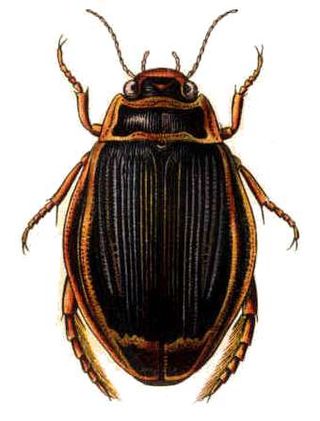
Dytiscus is a Holarctic genus of predaceous diving beetles that usually live in wetlands and ponds. There are 26 species in this genus distributed in Europe, Asia, North Africa and North and Central America. They are predators that can reduce mosquito larvae.

The Dytiscidae – based on the Greek dytikos (δυτικός), "able to dive" – are the predaceous diving beetles, a family of water beetles. They occur in virtually any freshwater habitat around the world, but a few species live among leaf litter. The adults of most are between 1 and 2.5 cm (0.4–1.0 in) long, though much variation is seen between species. The European Dytiscus latissimus and Brazilian Megadytes ducalis are the largest, reaching up to 4.5 cm (1.8 in) and 4.75 cm (1.9 in) respectively. In contrast, the smallest is likely the Australian Limbodessus atypicali of subterranean waters, which only is about 0.9 mm (0.035 in) long. Most are dark brown, blackish, or dark olive in color with golden highlights in some subfamilies. The larvae are commonly known as water tigers due to their voracious appetite. They have short, but sharp mandibles and immediately upon biting, they deliver digestive enzymes into prey to suck their liquefied remains. The family includes more than 4,000 described species in numerous genera.

Megadytes is a genus of diving beetles in the family Dytiscidae. They are found in slow-moving or static freshwater habitats throughout most of the Neotropics, ranging from Florida and Mexico, through the West Indies and Central America, to South America as far south as central Argentina. The adult beetles measure about 1.65–4.75 cm (0.6–1.9 in) long depending on the exact species and the largest is also the largest in the family.

Rhantus is a genus of beetle in family Dytiscidae. There are about 100 species distributed worldwide. They often live in pools and marshy habitat types. Several species have colonized oceanic islands and become endemics.

Acilius is a holarctic genus of diving beetles in the family Dytiscidae and typically has a life cycle that is univoltine.

Agabus is a large genus of predatory aquatic beetles in the family Dytiscidae, proposed in 1817 by William Elford Leach and named after Agabus, an early follower of Christianity. The adult beetles are moderate-sized, 5 to 14 mm long. The genus is primarily Holarctic in distribution, with only a few species known from the Afrotropical and Neotropical realms. Three species of Agabus, namely A. clypealis, A. discicollis and A. hozgargantae are endangered according to the IUCN Red List. The division into subgenera is not widely accepted. However, a number of species groups are recognized after the works of David J. Larson and Anders N. Nilsson. The genus is probably polyphyletic or paraphyletic. In a recent study of mitochondrial DNA, Agabus was found paraphyletic with respect to several of the species groups of Platambus, a closely related genus in the tribe Agabini. Lately the taxonomy of the genus has been revised, and some groups of species were transferred from Agabussensu stricto to other genera in the tribe Agabini.

Hydaticus is a genus of predatory water beetle belonging to the family Dytiscidae. Hydaticus can be found throughout most of the world. There are 150 described species and 12 subspecies in two subgenera in the genus Hydaticus.

Cybister, is a genus of beetle in family Dytiscidae. They are found in much of the world, including all continents except Antarctica. As of 2021 there are 96 species and 9 additional subspecies among four subgenera in the genus.
Neoporus is a genus of beetle in the family Dytiscidae. These are the predaceous diving beetles, a family of water beetles. Their larvae are commonly known as water tigers. Neoporus is one of over 160 genera in family Dytiscidae.

Sandracottus is a genus of beetles in the family Dytiscidae. These aquatic beetles are found in ponds and slow streams from South Asia east to southern Japan, and south to Australia. They are generally about 1–1.5 cm (0.4–0.6 in) long and often have distinctive markings.

Prodaticus is a subgenus of beetles of the genus Hydaticus in the family Dytiscidae. These 143 species are in the subgenus Prodaticus:
Hyderodes is a genus of beetles in the family Dytiscidae, containing only these two species:
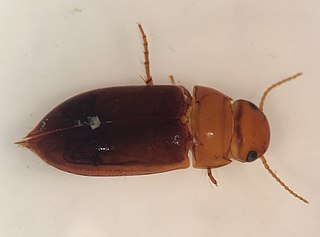
Celina is a genus of predaceous diving beetles in the family Dytiscidae. There are at least 30 described species in Celina.

Copelatus chevrolati is a species of diving beetle. It is part of the genus Copelatus in the subfamily Copelatinae of the family Dytiscidae. It was described by Aubé in 1838. There are two described subspecies: C. c. chevrolati and C. c. renovatus.
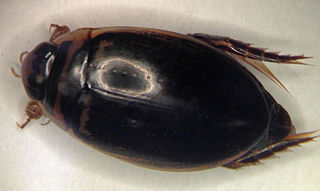
Thermonectus basillaris is a species of diving beetle native to the eastern United States, southern Ontario, Canada, and Cuba. T. basillaris is a pioneering species that occurs in temporary ponds and readily fly. Adults are 8.1 to 10.7 millimetres long and 4.7 to 5.9 millimetres wide.
Thermonectus sibleyi is a species of diving beetle native to western Mexico and southern Arizona, United States. T. sibleyi reaches a total length of 11.4 to 13.8 millimetres and has an overall light, speckled color pattern.

Laccophilus fasciatus is a species of predaceous diving beetle in the family Dytiscidae. It is found in Central America and North America.

Dytiscinae is a subfamily of predaceous diving beetles in the family Dytiscidae. There are at least 20 genera and 380 described species in Dytiscinae.
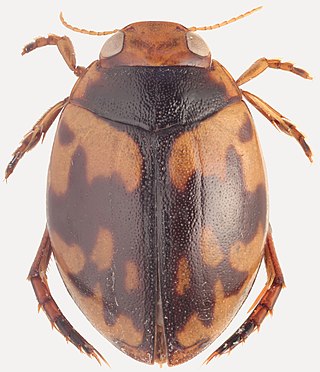
Hyphydrini is a tribe of predaceous diving beetles in the family Dytiscidae. There are about 16 genera and more than 390 described species in Hyphydrini.
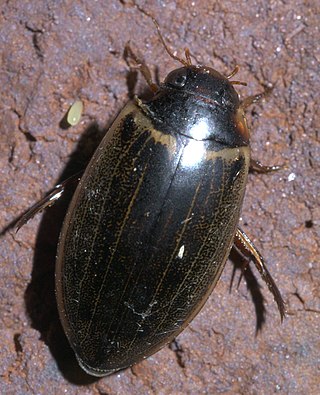
Meridiorhantus is a genus of predaceous diving beetles in the family Dytiscidae. There are about five described species in Meridiorhantus, found in the Neotropics and North America. These species were formerly members of the genus Rhantus, but were moved to Meridiorhantus when it was created by Balke et al. in 2017.


















